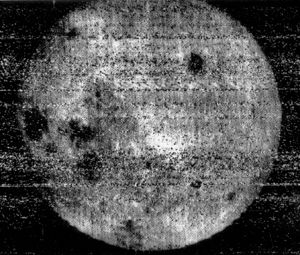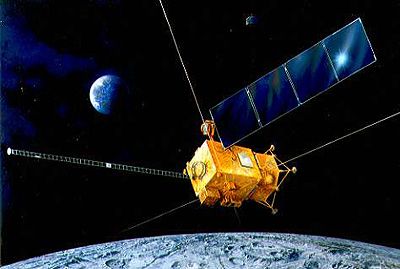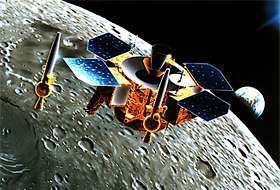Moon
Facts
A deserted and cratered world
The Sun and the Moon have always been mankind's guiding lights and yardsticks for everyday life. They have formed a celestial couple, adored and feared, influencing human existence. Since ancient times the Moon has inspired much folklore. How different it would be if Earth had several natural satellites, like Saturn's 33 companions! And if Earth had no Moon, its axis of rotation would wander chaotically, rendering the emergence and survival of life more difficult.
But the Moon is Earth's only natural satellite and the fifth largest satellite in the Solar System. It has a diameter of 3476 km, over a quarter of Earth's diameter and an eightieth of its mass. So similar in size, the Earth and Moon have often been considered as a double planet. Surface gravity on the Moon is one sixth of that on the Earth.
How high is the Moon?
The distance from Earth varies, 356 400 km at its closest, 406 700 km at its furthest. It revolves on its slightly inclined axis in 27 days 7 hours and 43 minutes, precisely the same as its orbital period, the time it takes to complete one orbit of the Earth. And turning in the same direction, the Moon always keeps practically the same face towards the Earth, locked in this configuration by gravitational laws. This face changes slightly on its borders as a result of several effects, thus a total of 59% of the Moon's surface can be viewed from Earth at some time or other.
The cycle of lunar phases is a consequence of the continuously changing alignment of the Sun, Earth and Moon over the Moon's orbital period. As days go by, the proportion of the Moon's sunlit side that is visible from Earth changes.
The magnitude of a full Moon never fails to impress, but this brightness is deceptive. This satellite's surface is actually quite dark. Its albedo, the fraction of the total light that is reflected from it, is on average only 0.067, lower than all the planets except Mercury. The Moon has temperatures varying from 123 °C in the day to -170 °C at night at the equator, and down to -233 °C in permanently shadowed polar craters.
Crater filled highlands and waterless maria
The Moon's surface displays two different types of terrain, clearly visible to the naked eye: brighter highlands, 'terrae' or 'continents', that cover 80% of the lunar surface (65% of the near side), and some 20 darker areas improperly called maria since these 'seas' are totally waterless.
The maria are like plains with few large craters. They correspond to the filling of old and large impact basins with basaltic lavas between 3.9 and 3.0 billion years ago. The oldest basins gave irregularly shaped mare (such as Tranquillitatis or Fecundidatis), while the most recent gave more circular mare (such as Crisium, Serentatis and Nectaris). The maria areas are concentrated on the nearside of the Moon, where they cover 35% of the surface. They cover only 5% of the hidden side of the Moon, with the largest Sea of Moscow first seen by the soviet Luna-3 probe.
Highest elevation formations were given the names of terrestrial mountains. One peak, Mount Leibnitz, culminates at 8000 m above its surrounding south pole areas. The highlands are filled with innumerable craters often 50 km in diameter. One estimate by the 19th century astronomer Julius Schmidt put the number of craters at 30 000. Today it is reckoned that there are at least 10 times that number, with a diameter larger than 1 km, on the visible side of the Moon alone. The largest exceed 200 km. Volcanic craters are rare and comparatively small. The lunar impact craters inform us about the history of Earth's bombardment since its birth.
Lunar elementals
As on Earth, oxygen is the most abundant element on the Moon's surface but in the form of oxides. There are lots of silicates everywhere. Magnesium, iron and titanium are enriched in the surface of the maria, as is an abundant quantity of pyroxene. The highland rocks consist mainly of feldspar, enriched with calcium and aluminium. Three minerals unknown on Earth have been discovered on the Moon. There are also traces of sulphur, phosphorus, carbon, hydrogen, nitrogen, helium and neon in the soil. The Moon surface is constantly exposed to the solar wind from which it traps the precious hydrogen and helium (and also the helium-3 isotope that could be used for nuclear fusion energy). The enhancement of hydrogen at the poles could be interpreted as a trapped deposit of water ice. These resources could be exploited in the future.
There is virtually no atmosphere on the Moon. The erosion process is thus from impacts of asteroids and meteorites as the myriad of craters testify. The most violent impacts fractured the lunar crust allowing internal magma to flow out. The surface is so churned by the small impacts that it has been transformed into a soil-like layer, the regolith, that can be 15 m deep.
Below this surface, the interior of the Moon consists of a homogeneous solid crust (50-75 km thick) and a mantle (lithosphere) down to some 800 km, and then an intermediary layer (asthenosphere) halfway to the Moon's centre at which may be a small core consisting essentially of molten iron. Moonquakes can occur, although rare and less powerful than on Earth. There is no significant magnetic field.
Mysterious birth and Earth-Moon evolution
Although the age of the Moon is generally recognised to be 4.6 billion years, the same as the Earth and other Solar System planets, the way it was formed is still an open question. Four models have been advocated in the past: capture, co-accretion, fission or collision.
The Moon may have been formed elsewhere in the Solar System and been captured by the Earth, but this poses dynamical and composition problems. The co-accretion model sees the Moon and Earth forming as a double planet system, but this raises composition problems. Finally the Moon could have been formed by fission of part of the early very fast rotating Earth's mantle to create a new body. Here arise dynamical issues. To date, the first three theories do not fit the evidence that has been accumulated notably as a result of lunar exploration. This has, for instance, clearly shown all the differences in the composition of the Moon and the Earth.
The most widely accepted scenario, is that the Moon is the result of a giant impact of a Mars-sized body, sending ejecta from both the early Earth mantle and the impacting body into orbit, where accretion later formed the Moon. However to narrow down the different collision scenarios and the early Earth-Moon evolution, one needs to measure the global and regional elemental composition of the Moon. This is a key science objective for SMART-1.
Why the Moon?
The conquest of the Moon
Today we know that the Moon is not made of green cheese and the cold-war race to the Moon is of another epoch. But Earth's natural satellite is certainly not relegated to the history books. Many people, scientists, engineers and poets alike, are still fascinated by it. A lunar eclipse can spell-bind thousands of watchers and when opinion polls recently asked what was the most significant event of the closing century, many replied by evoking just one name: Neil Armstrong.
The Apollo-11 astronaut's first steps on the Moon on 20 July 1969 materialised many dreams. The technology of modern society, backed by a formidable political will, transformed Jules Verne's novel 'From the Earth to the Moon' and Fritz Lang's film 'Frau im Mond' into reality.
The last crew included the only trained geologist to walk on the lunar surface, Harrison Schmitt. By the time he and Apollo 17 commander Eugene Cernan left the Moon on 17 December 1972, scientists were already adding this wealth of new data to the results of all the preceding unmanned lunar missions.
Much was learnt during the six Apollo missions that landed men on the Moon, and from Soviet lunar sample return missions. Carefully collected samples have been correlated with data obtained by lunar orbiters, including the most recent lunar missions.
Lunar probes and 'selenauts'
 |
|
Luna 3 Image of the Moon |
The first attempt by the United States was unsuccessful. Pioneer-3 was launched in December 1958 but failed to reach its target because of a booster problem. Less than a year later, the Soviet Union scored a bull's-eye when Luna 2 crashed into the Palus Putredinus region. In October 1959, the Luna 3 flyby allowed its cameras to discover for the first time the hidden face of the Moon.
By 25 May 1961, when John Kennedy made his famous speech to the United States Congress promising to take humanity to the Moon "before the decade is out", the United States and the Soviet Union had sent some 50 unmanned spacecraft to Earth's natural satellite. In a climate of intense competition, each mission claimed to be a 'first': first impact, first flyby, first images of the lunar farside, first soft landing, first circumlunar probe to return to Earth, first Moon 'rover'.
Each successful 'Pioneer', 'Ranger', Luna', 'Zond', 'Surveyor', 'Lunakhod', or 'Lunar Orbiter' added to our knowledge of the Moon, but also prepared the science and technology for future Solar System exploration, and for Earth applications. Each 'first' often took the form of impressive photographs and television pictures from which much science data was obtained. But the information from other onboard instruments (temperature sensors, a variety of spectrometers in different wavelengths, chemical composition analysers, seismographs, laser rangers, magnetometers, radiation monitors...) allowed the discipline of lunar and planetary science to advance by leaps and bounds.
The first lunar samples were collected by Neil A. Armstrong and Buzz Aldrin during the Apollo 11 mission in July 1969. Between 1969 and 1972 six Apollo missions brought back samples from six different sites on the Moon. Later, between 1972 and 1976, three Soviet automated spacecraft (Luna's 16,20, and 24) returned samples of lunar rock.
More Exploration Needed?
In preparation for future human robotic and physical expansion in the Solar System, lunar exploration is continuing, once again with automatic probes, using the far most advanced instrument and computer technologies of today. The successful HITEN (formerly called MUSES-A) Japanese mission was launched in 1990, to perform a sophisticated Earth-Moon circumnavigation, including Earth atmospheric breaking. HITEN was finally directed to impact on 10 April 1993 near Stevinus crater on the southeast part of the lunar side. This hyper-velocity planetary impact could be observed from Earth.
Between February and May 1994, the American Clementine orbiter observed the Moon with visible, and infrared imagers and a laser ranger which mapped practically the entire lunar surface with a 200 m resolution. Its most remarkable discovery was the strong mineralogical and tectonic large-scale inhomogeneity of the Moon. This explains why, even with the Apollo and Luna samples taken from near-side equatorial areas, we do not know the global Moon.
Clementine also discovered the South Pole Aitken basin on the far side, the largest impact basin (2500 km) in the Solar System. Clementine confirmed earlier evidence of permanently shadowed polar craters. A bistatic radar experiment looked at the possible presence of ice in certain polar craters. Clementine's first objective had been to demonstrate new technologies for the United States Strategic Defence Initiative Organisation but lunar and planetary science benefited greatly.
Lunar Prospector followed, launched in January 1998. The low-cost NASA Discovery mission had been designed to provide answers to long-standing questions about the Moon, its resources, structure and origins. Lunar Prospector's 18-month mission reaped very valuable scientific data, mapping thorium and potassium radioactive elements and iron. In March 1998 the Lunar Prospector team confirmed the existence of surface hydrogen, with an enhancement at the lunar poles interpreted as water ice. The spacecraft was then deliberately crashed into the Moon's South Pole, in the hope, a vain one, that this water projected into space would be observed and analysed from Earth.
Robotic Vision
After the launch of SMART-1, other lunar probes will follow. Japan's second Moon mission, 'Lunar-A' should be launched in mid 2004, to arrive at the Moon in mid 2005. After landing, it will hammer penetrators into the lunar crust and collect seismic data to estimate the size of the Moon's core. It will carry an equatorial black and white camera, whose data analysis will gain from SMART-1's multicolour images and spectrometric data.
Japan has set itself an ambitious long-term objective to set up a permanent Moon base. The following step consists in sending an unmanned four tonne spacecraft. Bearing the name of the Moon goddess, Selene is a science and engineering mission. It is comprised of a relay satellite in Moon orbit and an orbiter (from which a lander may be deployed depending on resources). Selene is to be launched in August 2005, for a 5 day cruise to the Moon. With the ESA SMART-1 mission as precursor, but still operating until the end of 2005, the Moon will thus see a trio of spacecraft that will be able to acquire combined data in synergy.
|
|
|
Japan's Lunar-A Mission (ISAS) |
 |
|
US Selene Mission (NASDA) |
The Future.....
Space enthusiasts often regret how, having left footprints on the Moon, no one went back there after the Apollo 17 mission in 1972. Man's return to the Moon is not for the immediate future. Other planets are also enticing us.
The Moon, however, is considered as a realistic first step for human expansion in the Solar System. Compared to Mars for instance, the Moon is closer, less hostile, far more accessible - and it could be a springboard to future manned exploration of the Solar System. High technology missions in orbit (such as SMART-1, Lunar-A, Selene) or on the surface with rovers and robotic outposts (under study) are within reach.
The scientific results and technology consequences of the recent lunar and planetary probes, and those scheduled over the next few years show a renewed and important role for the Moon as a testbed for science and technology, and for resource utilisation.

